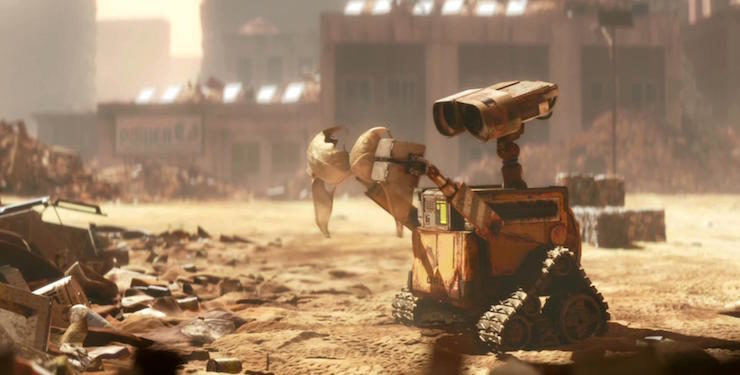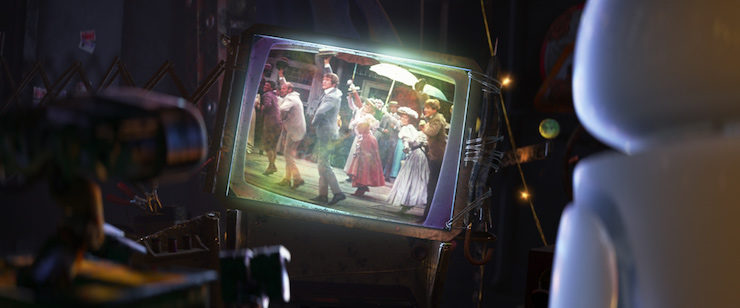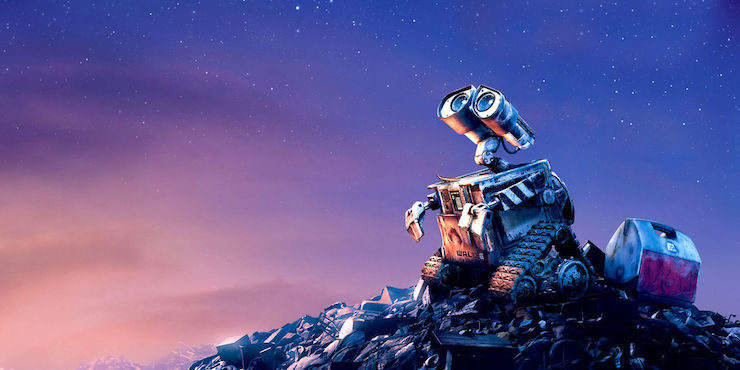WALL-E is generally referred to as a children’s film, and I’m not going to argue: it’s an excellent children’s film—a classic, absolutely. I also happen to think that it’s an even better movie for adults, for whom its lessons are more poignant, possibly more resonant, and more necessary. Pixar has a knack for producing films which consistently operate on two different levels: one which speaks to a young audience without condescension or pandering, and one which reflects adult experience, rather than just exploiting nostalgia for idealized conceptions of childhood or simply spiking the cinematic punch with snarky, Grown-Ups Only pop culture references and in-jokes.
Movies like WALL-E and Up deftly evoke complicated emotional responses in adults in a way that most children’s films don’t, speaking to adults on their own level through smart, subtle storytelling that’s often amazingly, heartbreakingly simple. Consider the opening sequence of Up, for example, which has the power to make grown men break down and sob as if they’ve just been kicked in the heart, but doesn’t seem particularly traumatic for small children at the same time; it’s not that kids don’t “get it”—they just don’t necessarily react to the sequence in the same way that adults, carrying a little more emotional baggage into the theater, tend to respond.
WALL-E is Pixar’s most sustained and arguably most successful experiment in employing this radical narrative simplicity. For the first twenty minutes of the movie, there’s basically no spoken dialogue, only recorded human voices echoing around a long-abandoned Earth. During the making of the movie, the Pixar team studied and drew inspiration from silent films, particularly those of Chaplin and Buster Keaton, and the influence is palpable throughout the movie, but especially in these opening scenes.
The irony, of course, is that the era of the silent film greats was defined by the limits of available technology—these artists were driven to perfect a unique mode of expression because of the challenges they faced in the early days of cinema. WALL-E himself is literally a product of technology, the discarded creation of a society with no such limits, but also no vision, which eventually self-destructed in a downward spiral of mindless consumption and apathy. In WALL-E’s reality, there isn’t any dialogue because there’s no longer anyone to talk to, to talk with. Oddly enough, when we eventually get a glimpse of human existence later in the movie, there’s still no dialogue—plenty of noise, prerecorded messages, automated announcements, and verbal commands, but no conversation, and certainly no meaningful interactions between people.
WALL-E shares a kinship with Keaton and Chaplin that goes beyond his movements and mannerisms—in short, he is an artist. The opening scenes of the movie establish the fact that he possesses a remarkable capacity for aesthetic appreciation. His function, as a robot, is to clean up the planetful of garbage left behind by humanity—a mindless, thankless task, or it would be, if he wasn’t able to spend his days sorting through the rubble, collecting objects which appeal to his natural curiosity and sense of beauty. His prized possession, of course, is a beat-up VHS tape of Hello, Dolly! —his (and our) only link to a vibrant, thriving human past. In a sense, WALL-E is the last holdout of romanticism, stranded in an isolated industrial wasteland—and where Keats had a Grecian urn and Wordsworth had all sorts of abbeys and daffodils to inspire him, WALL-E’s experience of the sublime stems from a random 1969 Barbra Streisand musical…and that is genius.
I love that we’re never given any background on Hello, Dolly!, no belabored exposition on what it was and why we should care, no cute backstory about WALL-E finding his precious video cassette—all that matters is the feeling it evokes, within the context of the story. It’s such a fascinating choice for such a central plot device—a bloated, big-budget spectacle that was both one of the last great Hollywood musicals (directed by none other than the legendary Gene Kelley), and also a box office disappointment which helped usher in the end of an era, as cheery showtunes and sequins failed to impress late 60s audiences more interested in edgier fare. The movie version of Hello, Dolly! isn’t iconic enough to be instantly familiar to most audiences, but that fact makes it such a brilliant choice in a movie that urges you to look at the world differently, to appreciate the inherent value of creation and expression wherever you can find it.
Through WALL-E’s eyes, a campy Sixties musical suddenly becomes a lightning rod of varying emotions: joy, longing, passion…it brings WALL-E and EVE together, reunites them when they’re separated, and even serves as a call to action in a robot revolt in the second half of the movie. When the captain of the Axiom starliner views the recorded video of Earth stored in EVE’s memory, he’s initially discouraged—until the clip of “Put on Your Sunday Clothes” magically appears, steeling his resolve and inspiring him, finally, to return to Earth. The lesson is driven home again and again: singing, dancing, music, and art have the power to connect, to further our understanding of the world; art is how we communicate—it can inspire revolution, redemption, and change for the better.
More than anything else, WALL-E is a movie about the importance of appreciating and creating art—without it, we are cut off from each other, and from ourselves. As far as depictions of dystopian futures are concerned, the movie is rather gentle—nothing about the cushy Axiom is likely to traumatize small children… but at the same time, its indictment of a culture entirely devoted to the mindless consumption of “entertainment” with no artistic merit or intellectual value is chilling the more you think about it. And the movie really, really wants you to think about it.
When you get right down to it, WALL-E can be considered Pixar’s mission statement; it’s basically a gorgeous, animated manifesto. Over and over again, it drives home the point that civilization and self-expression go hand in hand—humanity is defined by its ability to move beyond mere survival into the realm of art: it’s no coincidence that, after meeting WALL-E, the captain’s crash course in the history of the world moves from learning about basics like “soil,” “earth,” and “sea” directly into “hoedown” and “dancing”: this is a natural progression, according to the movie’s logic. WALL-E spends 700 years on his own (Hal, his adorable cockroach friend notwithstanding), but as soon as he encounters EVE, he immediately attempts to reach out to her by building a sculpture in her image–that gesture alone betrays more passion and humanity than any of the any of the actual humans in the movie are capable of mustering, until the very end. And this is why I think adults may have more to learn from WALL-E than kids do….
George Carlin famously said, “Scratch any cynic and you’ll find a disappointed idealist.” For me, more than anything else, WALL-E is a movie that speaks directly to the cynics, the apathetic, and to anyone who has lost touch with the fundamental urge toward creativity and expression, with the sheer joy and heights of emotion that art can bring. Just watching the closing credits is inspiring, as they move through the style of cave drawings, Greek and Roman art, Seurat, Van Gogh, all the way up through 8-bit video game-style graphics. It drives home the message that the world is full of inspiration, sometimes where we least expect to find it. It’s clear that the folks at Pixar see themselves as participating in this grand tradition that includes everything from ancient graffiti to Renaissance masterpieces to Modern Times, and 2001, and even Hello, Dolly! Every aspect of this movie is imbued with the power of its creators’ convictions: WALL-E is Pixar’s luminous love letter to the creative process…one which will hopefully continue to inspire adults and children alike for many years to come.
Originally published in June 2012.
Bridget McGovern is the non-fiction editor of Tor.com. She is making it her mission in life to mount an all-robot production of Mame, just as soon as she finishes building her Bea Arthur-bot. You can follow her on Twitter.














